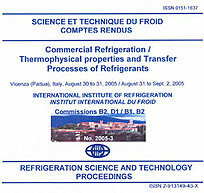
IIR document
Blends of CO2 and N2O as working fluids in cascade cycles.
Author(s) : DI NICOLA G., GIULIANI G., POLONARA F., et al.
Summary
The performance of a cascade refrigeration cycle operated with blends comprising carbon dioxide (CO2 or R744), nitrous oxide (N2O or R744A), with ethane (C2H6 or R170) as the low-temperature working fluid, was analyzed over a wide range of compositions and intermediate temperatures. To conduct the analysis, a property software based on the Carnahan-Starling-De Santis (CSD) equation of state was developed, using binary interaction parameters derived from our experimental data for CO2 + N2O and N2O + C2H6 systems, and from VLE data for the amply-studied CO2 + C2H6 system. The properties of the investigated blends were used to simulate the behaviour of a cascade cycle using ammonia (R717) as the high-temperature-circuit working fluid at the condensing temperature of 30 °C and operating at a low-temperature-circuit evaporating temperature of -70 °C. In the simulation, the value of improving the COP by using a suction-liquid heat exchanger on the low-temperature side of the circuit was also studied, as were the sensitivity of the COP to subcooling on the low-temperature condenser, and the temperature differences between the high-temperature evaporator and the low-temperature condenser. The results show that the N2O blends are an attractive option for the low-temperature circuit of cascade systems operating at temperatures approaching 200 K.
Available documents
Format PDF
Pages: 2005-3
Available
Public price
20 €
Member price*
Free
* Best rate depending on membership category (see the detailed benefits of individual and corporate memberships).
Details
- Original title: Blends of CO2 and N2O as working fluids in cascade cycles.
- Record ID : 2006-0558
- Languages: English
- Source: Commercial Refrigeration. Thermophysical Properties and Transfer Processes of Refrigerants. Proceedings of the IIR International Conferences.
- Publication date: 2005/08/30
Links
See other articles from the proceedings (140)
See the conference proceedings
Indexing
-
Themes:
CO2;
Blends - Keywords: Refrigerating system; Comparison; Nitrous oxide; Thermodynamic property; Simulation; Cascade system; Modelling; Binary mixture; CO2
-
Cascade cycles operating with CO2 + N2O binary ...
- Author(s) : DI NICOLA G., GIULIANI G., POLONARA F., et al.
- Date : 2007/08/21
- Languages : English
- Source: ICR 2007. Refrigeration Creates the Future. Proceedings of the 22nd IIR International Congress of Refrigeration.
- Formats : PDF
View record
-
Performance of autocascade refrigeration system...
- Author(s) : PARK S. N., KIM M. S.
- Date : 1998/06/02
- Languages : English
- Source: Natural Refrigerants, Energy Efficiency, Cost and Safety. Natural Working Fluids '98. IIR-Gustav Lorentzen Conference.
- Formats : PDF
View record
-
Comparative study on a dual temperature transcr...
- Author(s) : CHOUDHARY K. D., DASGUPTA M. S., SUNDER S.
- Date : 2018/06/18
- Languages : English
- Source: 13th IIR Gustav Lorentzen Conference on Natural Refrigerants (GL2018). Proceedings. Valencia, Spain, June 18-20th 2018.
- Formats : PDF
View record
-
Mélanges binaires pour un cycle en cascade inté...
- Author(s) : DEWITTE P., CLODIC D.
- Date : 1992/09/07
- Languages : French
- Source: Proposals for the generation and use of refrigeration in the 21st century.
- Formats : PDF
View record
-
Pushing the envelope: extending the range and p...
- Author(s) : LOW R.
- Date : 2020/07/31
- Languages : English
- Source: IIR Rankine Conference 2020.
- Formats : PDF
View record
